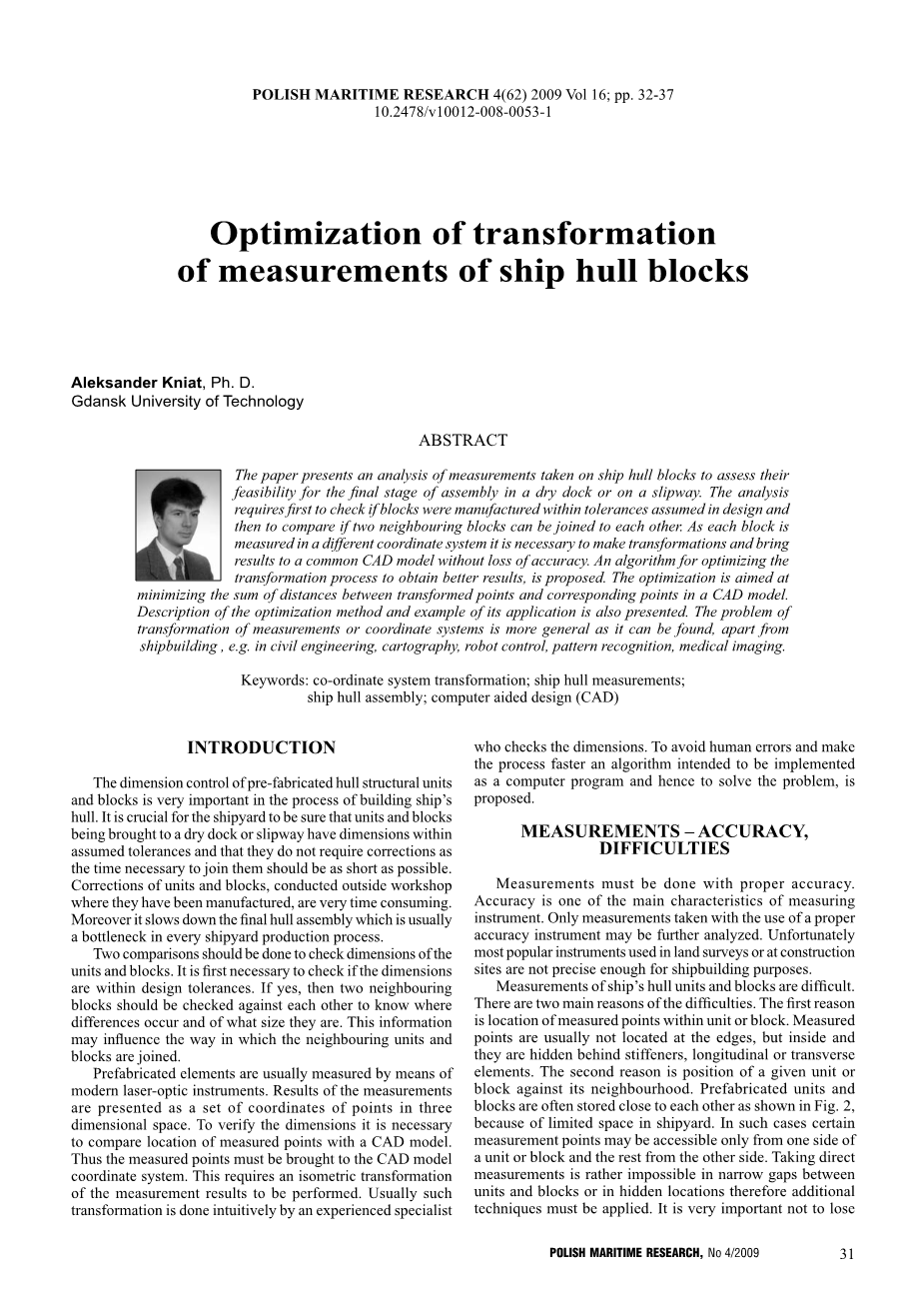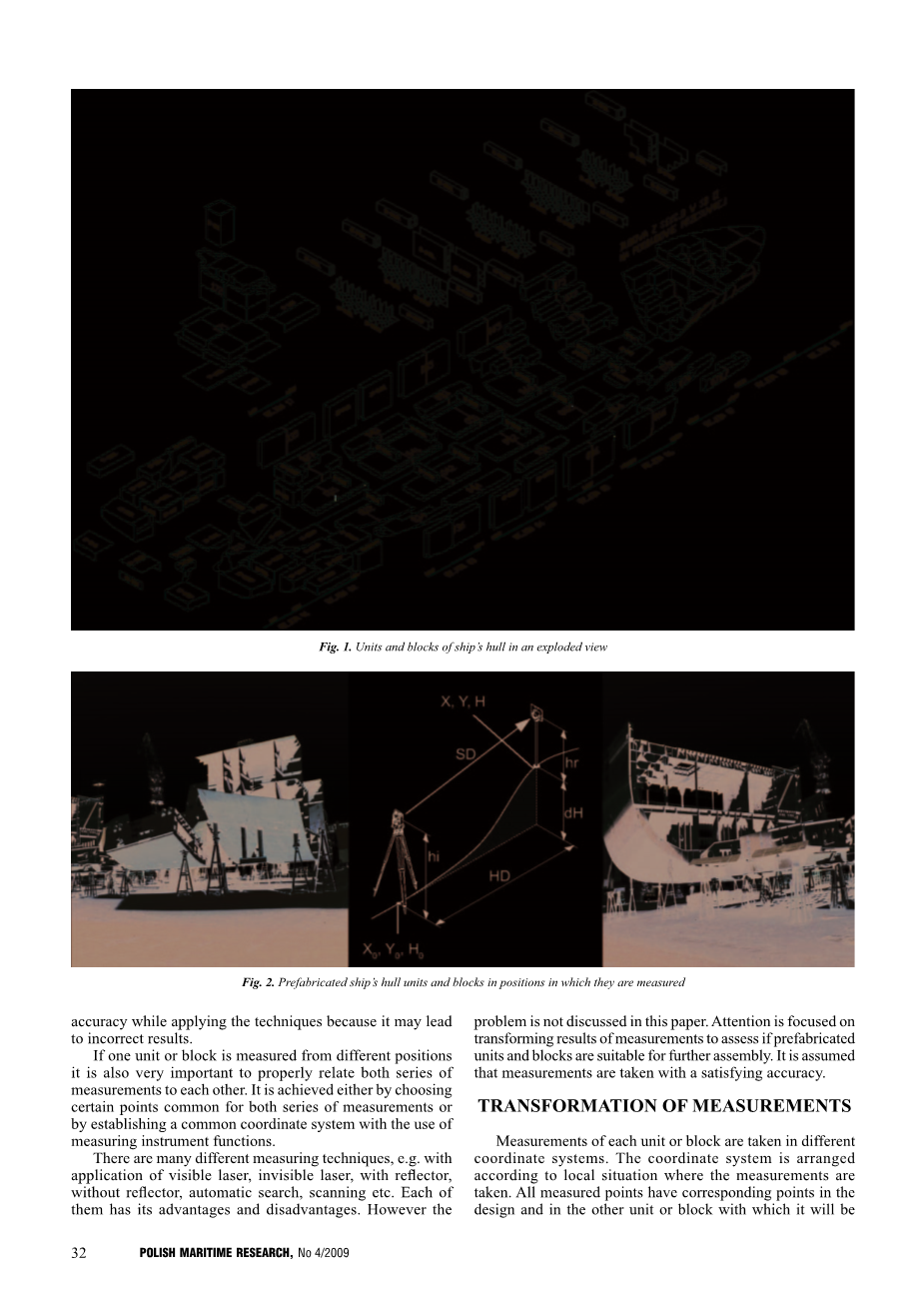英语原文共 6 页
Optimization of transformation of measurements of ship hull blocks
船体分段的测量转换的优化
Aleksander Kniat,Ph.D.(亚历克桑德·奈特博士)
Gdansk University of Technology(格但斯克工业大学)
ABSTRACT(摘要)
The paper presents an analysis of measurements taken on ship hull blocks to assess their feasibility for the final stage of assembly in a dry dock or on a slipway. The analysis requires first to check if blocks were manufactured within tolerances assumed in design and then to compare if two neighbouring blocks can be joined to each other. As each block is measured in a different coordinate system it is necessary to make transformations and bring results to a common CAD model without loss of accuracy. An algorithm for optimizing the transformation process to obtain better results, is proposed. The optimization is aimed at minimizing the sum of distances between transformed points and corresponding points in a CAD model. Description of the optimization method and example of its application is also presented. The problem of transformation of measurements or coordinate systems is more general as it can be found, apart from shipbuilding , e.g. in civil engineering, cartography, robot control, pattern recognition, medical imaging.
本文通过对船体分段的测量进行分析,来评估其在干船坞或滑道上装配的最后阶段的可行性。这个分析需要先检查船体分段在制造时是否满足限制条件,并对比两块相邻的分段是否可以连接。由于每一个分段都是在不同的坐标系下测量的,所以有必要进行一些转换并最终得到一个通用且准确的CAD模型。为了得到更好的结果,提出了一种使改进过程更优化的算法程序。这个优化是为了在CAD模型中,使变换点和对应点的距离之和取最小值。还介绍了该优化方法及其应用实例。在解决坐标的测量或转换的问题上的应用是很普遍的,除了船舶建造,还包括如土木工程、制图、机器人控制、模式识别、医学成像。
Keywords: co-ordinate system transformation; ship hull measurements;
ship hull assembly; computer aided design (CAD)
关键词:协调系统转换; 船体测量;船体总成; 计算机辅助设计(CAD)
INTRODUCTION(简介)
The dimension control of pre-fabricated hull structural units and blocks is very important in the process of building shiprsquo;s hull. It is crucial for the shipyard to be sure that units and blocks being brought to a dry dock or slipway have dimensions within assumed tolerances and that they do not require corrections as the time necessary to join them should be as short as possible. Corrections of units and blocks, conducted outside workshop where they have been manufactured, are very time consuming. Moreover it slows down the final hull assembly which is usually a bottleneck in every shipyard production process.
对预制船体结构部件和分段尺寸的控制在船体建造过程中是非常重要的。对于造船厂来说,确保被带到干船坞或滑道的部件和分段的尺寸在预设的误差范围内且不需要修正是至关重要的,因为连接它们所需的时间应该尽可能得短。
Two comparisons should be done to check dimensions of the units and blocks. It is first necessary to check if the dimensions are within design tolerances. If yes, then two neighbouring blocks should be checked against each other to know where differences occur and of what size they are. This information may influence the way in which the neighbouring units and blocks are joined.
检查部件和分段的尺寸应进行两次比较。首先必须要检查它们的尺寸是否在设计的误差范围内。如果是,那么接着应该相互对照检查两个相邻分段以了解误差发生的位置和它们的大小。
Prefabricated elements are usually measured by means of modern laser-optic instruments. Results of the measurements are presented as a set of coordinates of points in three dimensional space. To verify the dimensions it is necessary to compare location of measured points with a CAD model. Thus the measured points must be brought to the CAD model coordinate system. This requires an isometric transformation of the measurement results to be performed. Usually such transformation is done intuitively by an experienced specialist who checks the dimensions. To avoid human errors and make the process faster an algorithm intended to be implemented as a computer program and hence to solve the problem, is proposed.
预制构件通常通过现代激光光学仪器测量。测量结果用一组三维空间中的点坐标来表示。为了校验尺寸,有必要将测量点的位置与CAD模型进行比较。因此,必须将测量点带入到CAD模型坐标系中。这需要对要执行的测量结果实行一次等体积转换。通常这种转换由经验丰富的查验尺寸的专家直观地完成。为了避免人为错误并使进程更快,一种打算编写成电脑程序并用来解决该问题的算法被提出了。
MEASUREMENTS – ACCURACY,(测量-准确度)
DIFFICULTIES(难点)
Measurements must be done with proper accuracy. Accuracy is one of the main characteristics of measuring instrument. Only measurements taken with the use of a proper accuracy instrument may be further analyzed. Unfortunately most popular instruments used in land surveys or at construction sites are not precise enough for shipbuilding purposes.
测量必须以适当的精度进行。精度是测量仪器的主要特征之一。只有使用合适的精度的仪器进行测量才能进一步分析。不幸的是,土地勘探或建筑工地使用的大多数流行仪器都不够精确,无法满足造船目的。
Measurements of shiprsquo;s hull units and blocks are difficult. There are two main reasons of the difficulties. The first reason is location of measured points within unit or block. Measured points are usually not located at the edges, but inside and they are hidden behind stiffeners, longitudinal or transverse elements. The second reason is position of a given unit or block against its neighbourhood. Prefabricated units and blocks are often stored close to each other as shown in Fig. 2, because of limited space in shipyard. In such cases certain measurement points may be accessible only from one side of a unit or block and the rest from the other side. Taking direct measurements is rather impossible in narrow gaps between units and blocks or in hidden locations therefore additional techniques must be applied. It is very important not to lose accuracy while applying the techniques because it may lead to incorrect results.
船体部件和分段的测量很困难。困难主要有两个原因。 第一个原因是部件或分段内测量点的位置。 测量点通常不位于边缘,而是位于内部,它们隐藏在加强筋、纵向或横向构件后面。第二个原因是给定部件或分段对其相邻部分的位置。由于造船厂的空间有限,预制部件和分段通常彼此靠近存放,如图2所示。在这种情况下,某些测量点只能从一个部件或分段的一侧进入,其余的可从另一侧进入。在部件和分段之间或隐藏位置之间的狭窄间隙中进行直接测量是不可能的,因此必须应用其他技术。在应用这些技术时不要失去准确性是非常重要的,因为它可能导致不正确的结果。
If one unit or block is measured from different positions it is also very important to properly relate both series of measurements to each other. It is achieved either by choosing certain points common for both series of measurements or by establishing a common coordinate system with the use of measuring instrument functions.
如果从不同位置测量一
资料编号:[4272]
以上是毕业论文外文翻译,课题毕业论文、任务书、文献综述、开题报告、程序设计、图纸设计等资料可联系客服协助查找。




